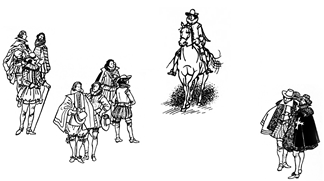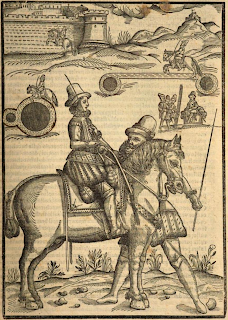Featured
- Get link
- X
- Other Apps
EQUESTRIAN VOICE AIDS
EQUESTRIAN VOICE
AIDS
Today's entry will cover something that, until now, has probably never been discussed, namely the use of voice aids in training horses in 16th- and 17th-century Italy. Since we can already imagine equestrian academies (LINK), where noblemen of the time traveled from all over Europe to acquire riding skills under the guidance of Italian masters (LINK) and understand how the equestrian techniques of that era looked (LINK), we can now add another dimension to it - sound.
My dear friend, a native Italian, Augusto
Boer Bront, who is a talented armorer by profession (LINK) and who has experience with horses, at
my request recorded audio commands found in Italian treatises. This will allow
us to imagine the sounds of equestrian academies and listen to them using the
buttons below.
DIVISION OF EQUESTRIAN AIDS
Claudio Corte (1562) distinguishes as many as nine equestrian aids: 'Di voce, di bachetta, di briglia, di polpe di gambe, di staffa, di speroni, di persona, di terreni, e d'acque.'- (The voice, crop, bridle, calf, stirrup, spurs, rider's body, terrain, water). As for the voice aid, he suggests that the rider should modulate the tone depending on the exercise and the 'fantasy' of a horse. He mentions that one should use a different tone for a foal, another for a horse that is starting to go well, another for a stallion, another for a lazy horse, another for an obedient horse, another during stopping, another in a fast canter, another in an canter with fury, another in ‘volte’ (tight turns) and 'raddoppiate' (pirouettes) and another in exercises over the ground and yet another in 'carriere' (charging with fury).
Federico
Grisone (1550) divides aids into seven types and singles out voice commands as
the ones the horse fears most:
'And take note well, that the horse can be disciplined in seven ways: by voice, by the crop, with the bit, by the calf of the leg, by stirrups, by spurs, by turning. The disciplining by voice, as I told you before, is the one that fears the most, and as long as it is done, the less [the horse] is upsets, and it helps in any disorder.’
Grisone also suggested applying voice aids to a sensitive horse before the rider uses spurs, allowing the horse to perform the maneuver better and without additional aids. This approach also enabled the rider to recognize how much aid the horse needed.
VOICE AIDS
1. MOVING FORWARD & URGING- Corte wants a rider to use the voice women make when they call their chickens, which is done by attaching the tongue to the palate and keeping the lips open, then immediately detaching it, making a sound- this is a description of clucking. Corte suggests using this cue at the walk, at trot, at fast canter and at furious gallop. Grisone suggests clucking to move a young horse forward or when the horse lacks 'passion' in executing a maneuver.
2. POSATA & CORVETTE & TURNS IN PIROUETTE - Clucking was recommended by Pasqual Caracciolo (1566), Grisone, and Corte, also for more complex maneuvers such as 'posata' (similar to levade), 'corvette' (similar to modern terre a terre) and tight turns in 'volte' (pirouettes). Grisone for those who wanting to make a tight turn recommended executing 'posata', where, along with other aids, clucking encouraged the horse to lift, and when the horse was in the process of performing the second lift (being front in the air). Another cluck should be given and the horse should be turned to the chosen side.
-‘Hop,
hop’
-‘Hop, hop’
4. STOP & ‘HALF HALT ‘- When a horse already had a good understanding of how to stop, he only required the voice aid, while the use of spurs and the crop was left to discipline him and allow for free forward movement (Grisone). Caracciolo recommended the same aids as Grisone for holding the horse back so that he went more safely on his legs, more elevated, and lighter on the front:
-‘Hap,
hap’
-‘Hep, hep’
5. CHARGE- Grisone, Caracciolo, and Corte, to urge the horse into 'repolone' (passada) for a full-speed charge on a straight line (carriere), used words like:
-‘Eya, eya’
-‘Via, via’
-‘Ai, ai!’
6. BACKING UP- Grisone, to back up the horse, in addition to the help of the crop and reins, recommended saying in a deep tone:
-‘Addietro, addietro’ (Backwars, backwards)
7. CIAMPETTA / GAMBETTA- When teaching this maneuver, which is a half pirouette (180-degree turn) performed in one stride by the horse (now called in the Doma Vaquera school - 'media vuelta'), according to Corte, to lift and turn the horse, one should say:
-‘Sù, sù’ (Up, up)
-‘Leva, leva’ (Lift, lift)
8. KNEELING- When wanting to teach a horse to kneel, Claudio Corte recommended using:
-‘Giù, giù’ (Down, Down)
-‘Abbassa, abbassa’ (Abase, abase)
VOICE PUNISHMENT
Grisone, as
the only one, presented us with a whole range of 'reprimands' that could be directed towards a horse to mitigate and
make him obey.
‘(...) I am telling you that when [the horse] demonstrates any misbehaviour, such as shaking his head, rearing up, bracing against the bit or proceeding with other errors, the voice punishment must be full of horror and anger. You will say with a harsh rebuke whichever you like the most any of these words:
|
-‘orsu, orsu’ -‘o la, o la’ -‘ha ha traditore’ -‘ha ribaldo’ -‘torna, torna’ -‘ferma, ferma’ -‘torna qui, torna qui’ |
(Come on, come on!) (How now, how now!) (Ha, ha, traitor!) (Ha scoundrel!) (Come back, Come back!) (Stop, stop!) (Come back here, come back here!)
|
(...) you will continue this until he ceases to disorder. Make your voice more or less loud, depending on the severity of the error.’
REWARDING BY VOICE
Grisone also writes about how to reward a
horse once it is calmed down.
‘But
when he gives up, you must immediately be silent, or with a pleasant and low
tone change your voice, always assuring him and touching him with your right
hand on the crest of the neck, either along the mane or towards the withers,
sometimes scratching him or with
a subdued voice saying this:
-‘Ho, ho, ho, ho’
WHISTLE OF THE CROP
However, voice aids could not only be given using the rider's mouth but also with the riding crop. Valerio Piccardini, in 'grupato' (where the rear and front part of the horse jumps at the same height - similar to contemporary terre à terre), recommended that during a change of direction - simultaneously changing the aid from one side to the other with the riding crop – a rider should produce a whistle or touch the horse to help him straighten.
COURT ETIQUETTE
Claudio Corte emphasized that voice aids should not be used in the presence of princes and dignified gentelmen. It was not allowed to scold horses or scream loudly in their presence. This restriction applied not only to mere shouting but also to the fact that the rider would have open mouth gestures in the presence of dignified people. Pirro Antonio Ferraro (1602), recalling riders who twist their torso, kick with their legs, and shout like hunters, considers such habits clear and obvious sign that they have learnt the art of riding without a master. He further writes:
‘Therefore, if a musician should not excessively open his
mouth, a speaker should not use disproportionate gestures, and a fencer should
not indecently toss his head, I do not know why so many shouts and movements of
people riding horses are allowed.’
PS.
I allowed myself to borrow the drawings from one edition
of 'The Compleat Horseman’ (1614) by Gervase
Markham, edited by Dan Lucid with pictures by Pauline Baynes (1975).


















